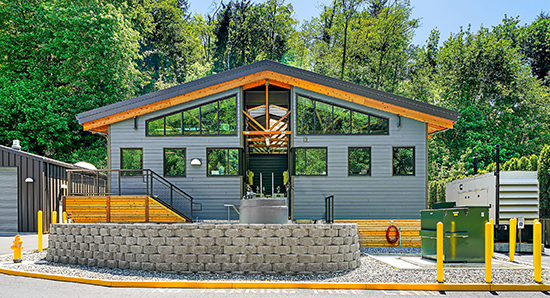|
Subscribe / Renew |
|
|
Contact Us |
|
| ► Subscribe to our Free Weekly Newsletter | |
| home | Welcome, sign in or click here to subscribe. | login |
Construction
| |
 |
March 28, 2022
Best in State: Gold Award
Unique or innovative application of new or existing techniques

BHC Consultants
Project: Salmon Creek WWTP solids handling improvements
Client: Southwest Suburban Sewer District
The Salmon Creek Wastewater Treatment Plant, constructed in 1956 and upgraded once in 1988, needed significant upgrades to meet current demands for capacity and modernization of electrical, control, office, and laboratory facilities.
Owned and operated by the Southwest Suburban Sewer District, the plant treats sewage from about 40% of the district’s service area, including portions of Seattle, Burien and unincorporated King County.
The Salmon Creek solids handling improvements project included significant design challenges for the BHC Consultants team. The site, located at the bottom of two ravines, is surrounded by sensitive areas on almost all sides with limited land available. Expansion required some unique and creative solutions to accommodate a new anaerobic digester and expand the biosolids loading bay, the office, and the laboratory.
The project goals included increasing biosolids digestion capacity, improving biosolids dewatering efficiency and hauling capabilities, and modernizing and expanding office and laboratory space for current staffing levels. The electrical and control systems needed upgrades to increase reliability and redundancy. Additionally, it was necessary to maintain the continuous operation of the treatment system throughout construction while keeping costs low to ratepayers.
The only location available for a new anaerobic digester was at the toe of a steep slope with artesian groundwater and overlapped with the existing operations building and odor control system. The modifications to the operations building required the removal of a digester tank and converting another tank into a basement for mechanical equipment. The replacement digester design accommodated the seismic-derived lateral loading requirements by making the soldier pile and tie-back shoring system needed for construction a permanent system. This reduced lateral loadings on the digester tank structure and significantly simplified the tank design and construction.
An expanded biosolids loading bay was required to accommodate larger 40-foot semi-trailers, which necessitated the removal of the existing office and laboratory space. The available footprint was too small to accommodate a new larger building, so the design team’s solution located the building on top of an existing structure.
Hollow-core concrete planks with concrete topping and a cantilevered perimeter spanning the existing tank streamlined construction and provided the necessary footprint. A hybrid building frame using structural steel, structural insulated panels, and conventional pre-engineered wood trusses offers high energy efficiency and natural lighting.
The new building and reconfigured structures met all project objectives using a hybrid-design approach, combining multiple materials and systems to accommodate structural needs and architectural goals.
Other Stories:
- National Finalist: Platinum award
Special Projects - National Finalist: Gold Award
Special Projects - National Finalist: Gold Award
Water Resources - National Finalist: Gold Award
Transportation - Best in State: Gold Award
Social, economic and sustainable design - Best in State: Gold Award
Complexity - Diversity and Inclusion Award: Mid-Size Firms
- Diversity and Inclusion Award: Large Firm
- Engineer of the Year
- Best in State: Gold Award
Social, economic and sustainable design - Best in State: Gold Award
Successful fulfillment of client/owner needs - Best in State: Gold Award
Future value to the engineering profession - Best in State: Gold Award
Future value to the engineering profession - Diversity and Inclusion Award: Mid-Size Firms
- National Finalist: Gold Award
Structural Systems


